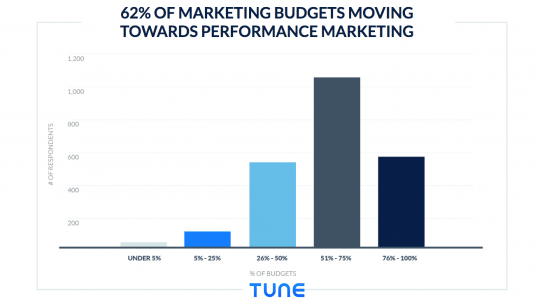
I’d like to say that 2017 was a wild year where ground breaking marketing technology powered life-altering marketing campaigns, but I can’t.
There continues to be a shortage of real innovation across the mobile acquisition and engagement space as providers battle it out on a feature-to-feature basis. The result? An industry content with the status quo as marketers focus more on iterative advances and existing technologies than new solutions that push boundaries.
Despite this general stagnation, I’m hopeful that 2018 will be a breakout year for the industry, as we work to execute on three important strategies: 1. The creation of a unified, enterprise-ready mobile marketing stack that goes well beyond basic attribution; 2. Expansion of people-based marketing by further linking devices with real people so marketers can actually provide their target audiences with customized campaigns (and not just talk about doing it); and 3. A laser focus on the creation of new technologies and solutions that will enable marketers to reach new audiences at scale.
That’s what we’re up to. Here are my six predictions for 2018.
1. Acquisition and Engagement Unite!
We often talk about the all-important sales and marketing bucket here at TUNE, and how we can help our customers plug the various leaks that develop over time.
When marketers turn on the faucet of user acquisition to drive downloads, registrations, and initial engagements, a massive 80% of customers leak within the first three days, never to return. Of those who remain, another 8% are lost to fraud, meaning marketers end up with very few customers as a result of a leaky bucket.
We want to build tools to help marketers plug the leaks. But before we do it’s really important to understand what creates the leaks in the first place: an overinvestment in acquisition without a corresponding focus on retention via engagement.
In 2018, marketers will take a more holistic approach to balancing new customer acquisition with engagement and as a result improve retention. As they do, they’ll design higher-performance campaigns that are more focused, engaging, and context-relevant. In short, they will become MobileBest marketers.
2. Marketing Not Held Accountable Will Dwindle
I mention this every year, and I’ll continue doing so well into the future, but it’s time the mobile industry *finally* delivers more for consumers and enterprises.
To get there, we need certain patterns of media buying to officially die off. Slinging display ads with no performance measurement will become a small game, dependent purely on sales tactics and relationships. Companies are already demanding that their marketing teams measure performance in order to demonstrate fiscal accountability, and that trend will fully take root in 2018. This will become especially notable once enterprise companies unlock the revenue predictability and scale that performance provides.
This means we’ll see a transformation in programmatic and large scale media buying as a result of solid measurement. We have the technology to track results at scale, so there’s no reason why marketers can’t deliver great results to consumers and enterprises alike.
3. The Year Mobile Breaks Through in Enterprise
Enterprises realize that mobile is mainstream, and we’ve done the research to prove that focusing on mobile increases company value. They’ve also discovered that their teams may not have the deep expertise or tools to win because yesterday’s digital campaigns don’t translate to today’s mobile demands. This is a massive opportunity for vendors who can deliver enterprise-level capabilities across marketing touchpoints.
I see it in our own customer growth and it is a consistent theme across mobile marketing vendors and companies I talk to. Enterprise companies are diving into mobile, signing up for new tools and software, and preparing to compete with mobile-first companies in 2018. They’re committing to big software contracts and showing incredible plans for their mobile marketing budgets. Many are moving from tiny investments in mobile to what will be the largest in their marketing mix. Don’t get me wrong, we’ve seen Fortune 100 companies involved in mobile for years now, but the amount of commitment and investment is going up dramatically.
The hidden challenge for enterprise companies is marketing talent. They’re working from a cast of digital marketers that don’t speak the language of mobile, and it’s slowing down their journey. In short, if you’re a mobile user acquisition specialist, your career in enterprise is about to blossom.
There’s also a disconnect when it comes to the maturity of big-box marketing cloud vendors, who designed and built great web marketing offerings but are scrambling to bolt on mobile offerings in order to compete with mobile-first startups. Enterprise marketers will adopt technology that unites the best of big box marketing cloud tech with innovative startup tech into one package. This space will be won by the company that provides top notch service, support, up-time, and security (things you get from a big-box cloud) with new super useful products and new features delivered at a rapid pace.
4. Walled Gardens Begin to Erode
In some categories such as elimination of fraud and the erosion of walled gardens, 2018 will be a year of addition by subtraction; in others like OTT (over the top) and voice, it will be a year of reaching audiences across more channels than ever before. In all cases, a catalyst will be technology that consolidates perspectives and enables more informed action.
Today, “walled gardens” like Google and Facebook generate an incredible volume of data on individuals through search, display, social connections and likes. Today these worlds are separate, making it increasingly difficult for marketers to reconcile performance across multiple platforms.
Within the next five years, Google and Facebook will begin sharing data and showing marketers a more complete picture of measurable results. They will do this through siloed, protected analytics environments, measured by third parties capable of ensuring unbiased accuracy.
In 2018, we’ll also see more experiments and “frenemy” partnerships, the first of which was recently announced when Salesforce and Google agreed to partner to help marketers get a more complete and accurate assessment of the impact of their spend. This is a clear indication of what’s to come.
The world is more open and collaborative and as a result value will migrate to solutions that connect and unify rather than those that remain divided (and create unnecessary work for their customers).
5. Streaming Video (OTT) and Voice Technology Show Their Potential
As mentioned above, OTT and voice are helping marketers reach target audiences in new and innovative ways. It’s early for OTT and voice platforms like FireTV, AppleTV, Chromecast, Roku, Amazon Echo and Google Home but they will unlock a broader set of audiences and channels for marketers to test and explore. In 2018, streaming video and voice technology will explode in marketing popularity as more native advertising opportunities are made available.
Voice will move a bit slower in 2018 because its economic potential has not yet fully materialized the way it has for OTT within the ecommerce sector, for example. However, marketers must make more investments in understanding the consumer experience on Amazon Echo, Google Home, and Siri, and I expect there will be some shining examples as a result. This is going to be fun.
6. Marketers Get a Handle on Fraud and Realize They Need Quality Supply
A major topic for marketers in 2017 was ad fraud, and every attribution technology provider worth their salt scrambled to carve out their own story. At TUNE, our customers helped us innovate massively on our fraud solutions. We needed a new level of publisher granularity as well as the tools to make it simple to cut out everything suspicious. I’m really proud of the collaboration and think the results speak for themselves. On top of all that, the platforms are becoming more active. For example, Android launched a new API that we jumped on to eradicate fraudulent click injection.
For technology providers, the focal point will be improving the experience for marketers in dealing with fraud and arbitrating with partners (think more automated actions and identified rules).
Because fraud is easier to identify and manage, marketers will be willing to pay more for quality supply. Enter Amazon, Apple, Snap, etc.
Marketers will continue to maximize monthly performance with Facebook and Google and will look to increase spend on other channels, from ad networks to exchanges. They’ll be hungry for more native advertising from sources such as Apple Search and Snapchat. This will cause inventory prices to climb and will open the door for new contenders. One of those contenders will be Amazon.
Wrap Up
The mobile marketing industry is primed for change and I’m confident we’ll see it in 2018. Too many forces are at work for significant advances not to reach critical mass and begin truly transforming how marketers identify and engage their audiences. In summary, I’ll be shocked if 2018 is a repeat performance of the past year.
The TUNE team and I will be doing our part to introduce new technology and shape the future of our industry. We know it will be challenging and invite you to join us for the ride.
Have a prediction? Feel free to leave a comment and let me know what you think will happen in 2018.
Author
A digital marketer by background, Peter is the former CEO of TUNE, the enterprise platform for partner marketing. In 2018, he sold TUNE’s mobile measurement product to Branch, unifying measurement and user experience. He led TUNE’s efforts to bring better management technology and automation to marketing partnerships, across affiliates, influencers, networks, and business development relationships. Follow @peterhamilton




Leave a Reply
You must be logged in to post a comment.